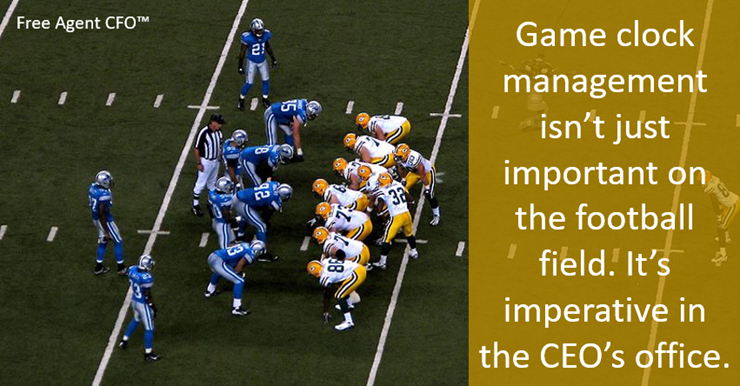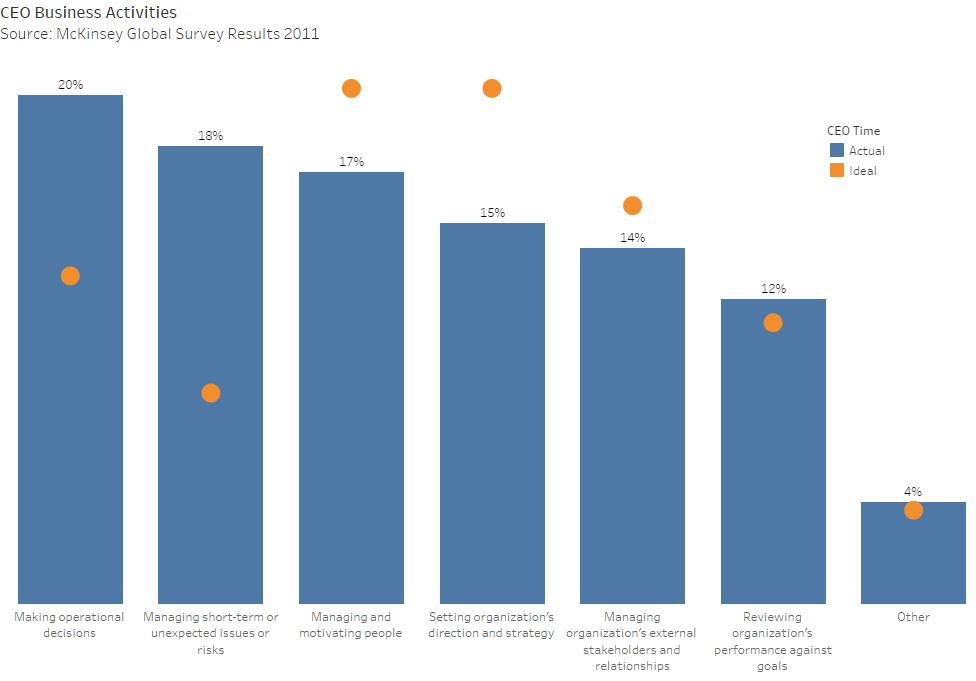Where Are CEOs Spending Most of Their Time?
One of the most gifted and creative consultants I’ve ever met is Mike Schrader who is based in Columbia, Missouri.
Mike once said the first thing he asks a new client/owner is how they spend their time. He’s even had them track it for a week or two allowing him to be a better coach to them.
When I broke into consulting focusing on controllership activities, that made no sense to me at all. I always thought the role of the CEO was to fix problems. Slowly, I began to get it. That’s not their job. Right?
The CEOs We Serve Are Missing the Mark on Priorities
There are no surprises in a McKinsey Global survey tracking where CEOs spend their time. Many are stating they want more time to plan and motivate staff as shown in the 2011 results below.
The results above are telling.
- CEOs are spending nearly double the time they should be on managing unexpected issues meaning they are not good at delegating or they don’t have the right team members in place.
- Likewise, they are also spending double the time planned in fighting fires when they could be focusing on culture, brand building, and business development.
- Not enough time is spent on direction and strategy, but at least we know why.
- There’s also not enough time spent coaching and mentoring the staff.
We Have a Great Coaching Opportunity in Front of Us
In short, our clients are spending too much time fighting fires and making operational decisions that could be delegated to trusted staff.
What’s that you say? Your clients are too controlling? Or they don’t have a (good) management team?
If that’s true, these business owners are going to be entrapped in their businesses for a very long time. And good luck on a nice payday when they decide to call it quits.
Here are three ideas to get your CEOs on track and spending time where it’s needed most.
1. Start with Baby Steps
In case you’re curious, I still have these clients. But I find spoon-feeding works best. Start small. Circle a day on the calendar when you and your client will get out of the office to plan what the business will look like 3 years from now, and then 5.
Work backwards or reverse-engineer how to get there.
Consider asking the Dan Sullivan R-Factor Question® which goes something like this:
If you and I were meeting 3 years from now, looking back, what would it take for you to feel happy about your progress?
I’ve asked that question hundreds of times. When I ask new clients, sometimes the answer takes up more than an hour. Such a simple question, but one that causes deep introspection for a business owner who is not used to thinking beyond the present.
2. Start Identifying Team Members That Can Step it Up
So your client is making all the decisions? If it’s because they have a controlling personality, that’s a tough nut to crack.
If not, there’s hope. By now, you should have already identified who that number 2 person is, and then the next. Those are the people who have to start making more of the day-to-day decisions as issues arise. If not, your client will remain enslaved in his/her business.
Missing key team members? Then it’s time to reload. Again, that’s where you can play a key role in hiring new team members. You can be a filter for who he/she brings on.
I’ve been thankful that two of my clients have had me give the green light on CFO hires. I’ve also been asked to participate in other key hires. Your role here can make a big difference toward adding value to the business. Not only that, the CEO you are serving can start focusing on what’s important.
3. Next Steps
The Free Agent CFO™ is far from one dimensional. We’re not just finance people. We’re holistic. We’re great at stepping back and seeing what needs to be done in every facet of the business.
Find out where your clients are spending their time. Here is hoping your arm is not too short to save as you pull them out of the gaps they have created for themselves.
Note on Chart
If you are having a hard time deciphering the charts, feel free to look at them on my Tableau Public site where the images are larger.







